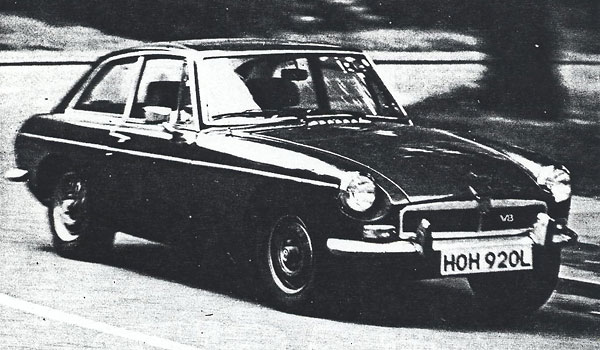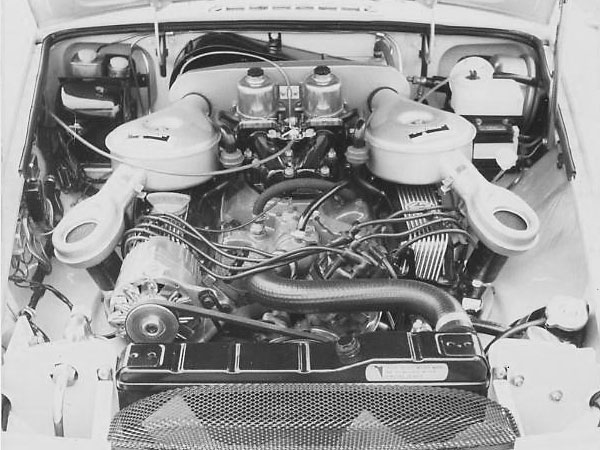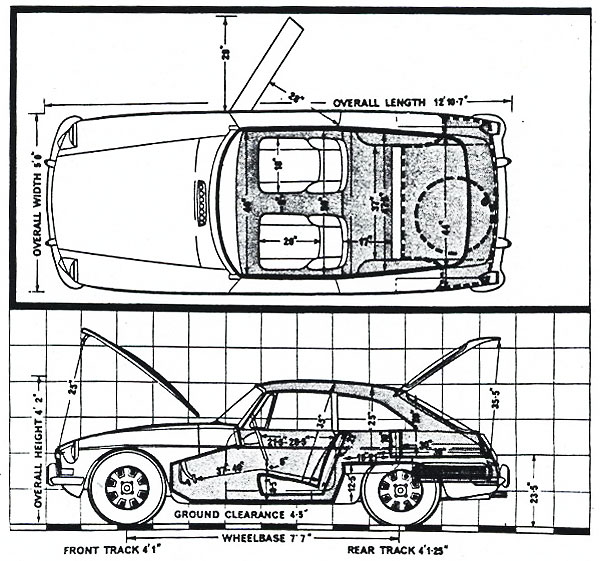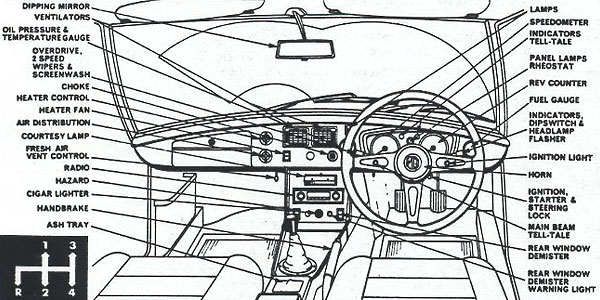�

�
Auto Test: MGB GT V8
�MG Elegance, Rover Smoothness
��
as published in British V8 Newsletter, Volume XV Issue 3, December 2007�
�
Re-printed unedited by exclusive written permission of "Autocar".
�
This article originally appeared in their issue for the week ending August 16, 1973.�
�
Effective combination of proven MGB GT and superb Rover 3500 V8. Good performance with �
remarkable economy. Smooth fuss-free engine with good torque but little engine noise. �
Perennial MGB faults. Too expensive. �
�
Few cars have been more of an open secret than the MGB GT V8. From the moment that supplies �
of the Rover V8 engine to Ken Costello were stopped, it was clear that British Leyland themselves �
were intending to do a similar exercise. �
�
There is a considerable market all over Europe and America for a smart Grand Touring car with �
comfortable space for two people and their luggage, or for two and their small children or �
their dogs, and such cars as the Reliant Scimitar GTE and the Lotus Elan +2 have sold well �
as a result. It must also have worried British Leyland that they were not represented in �
the "big" sports car range by the Austin Morris Division, following the termination of the �
Austin Healey 3000, and the unfortunate public response to the MGC that led to its early �
demise. As we said when the MGC was first tested, if there were no MGB by which to measure �
it, the MGC would not have been considered such a bad car, and so it is heartening to see �
that British Leyland are again prepared to capitalize on the excellent name of "MG" and to �
try again. �
�

�
The elegant Pininfarina-inspired lines are unaffected by the change in power unit, revised manifolding avoiding the
�
need for a re-shaping of the bonnet. The familiar MG insignia on the radiator has returned to its previous position at
�
the top centre of the grille surround, while the surround itself has returned to the shape and size that it was before
�
the 1971 revisions.�
�
The combination of the timeless lines of the Pininfarina-influenced MGB GT and the smoothness �
of the lightweight 3,528cc Rover V8 engine ought, on paper anyway, to make for an excellent �
high performance sporting coupe. If the end product falls short in any way, it is in the �
unfortunate perpetuation of the dated features of the MGB. Such shortcomings as excessive �
wind noise, a harsh ride, and heavy steering may be forgiven in an out-and-out sports car, �
but they have no place in a GT car costing over £2000. More unfortunate still is the �
fact that such shortcomings are accentuated by the superb smoothness and relative quietness �
of the excellent Rover V8 engine, which it must be admitted goes most of the way to making �
up for the less likeable facets of the car. �
�
In terms of performance, the Rover engine has moved the MGB GT V8 up into the realms of the �
fastest European sports cars as it is capable of well over 120mph and its acceleration both �
through and in the gears is excellent. Acceleration from rest to 90mph in under 20 seconds, �
and a standing quarter mile time of 16.4 seconds are both very good, and the effortless way �
in which the quiet V8 accelerates from as low as 10mph in top gear is impressive. In direct �
top-gear, each 20mph increment from 10 to 80mph takes less than 8 seconds, while it takes �
only 10.3 seconds to get from 80 to 100mph. �
�
To provide this sort of performance, while paying attention to European Emission Regulations, �
British Leyland use a version of the V8 engine that has most in common with the Range Rover, �
utilizing the same low-compression pistons in both engines. To allow for a sufficiently low �
carburetor height, the manifold is changed from the penthouse design of the Rover 3500 and �
Range Rover, and a cast manifold is used, whose inlet tracts point towards the back of the �
engine enabling the carburetors to be positioned close to the bulkhead, where there is more �
available space. �
�

�
There is little to show that the Rover V8 engine is not the original power unit of the �
MGB GT V8, as the installation is
�
neat and well planned. The electrical service items such as fuses and relays are all �
positioned on the offside of the
�
bay, while the radiator header tank and screen washer reservoir are on the nearside. The reservoirs for clutch and
�
brake hydraulic circuits are positioned high up behind the pedal box, but their proximity to the angle of bulkhead
�
and bonnet makes it difficult to see the fluid level. (Photo by Ken Smith. Used by permission.)�
�
The gearbox derives from the MGC all-synchromesh unit that was introduced on all MGBs in 1967. �
As used on the MGB GT V8, only the casing is changed to allow the use of a 9.5 inch diameter �
clutch, while the internal ratios are higher than those of the 4 cylinder car to suit the �
increased power and torque of the much larger engine. The ratios are well chosen, allowing up �
to 40mph in 1st gear, and 100mph in third gear. Although 2nd gear gives up to 60mph, it is �
spaced a little too close to 1st gear and would benefit from being a little higher. �
�
Overdrive operates on top gear only and is geared up to give 28.5mph/1000rpm. While this may �
seem to indicate a strictly "overdrive" gearing, it is surprising how often it can be engaged, �
even around town, so torquey is the V8 engine. Engagement of the overdrive is by the lefthand �
of two fingertip stalks, and while the unit disengages sweetly enough when the lever is pushed �
away from the wheel rim, engagement is lazy and unduly speed-conscious, taking longer to �
engage at low speeds than high, as the inhibitors sort themselves out, and decide whether or �
not overdrive can be engaged. �
�
Enjoying this article? Our magazine is funded through the generous support of readers like you!
�
To contribute to our operating budget, please click here and follow the instructions.
�
(Suggested contribution is twenty bucks per year. Feel free to give more!)�
�
One of the nicest features of the car is the complete absence of any snatch, vibration, or �
harshness from the drive-line. From full throttle to overrun, there is little sign of the �
considerable torque reversals that are taking place, and this contributes greatly to the �
pleasure of driving the car. As this feature is present to a lesser degree in the Rover �
3500S it is probably due in part to the V8 engine, but the very short propshaft must help �
considerably in this. �
�
There are absolutely no dramas involved in starting the car, either cold or hot. Under �
cold-start conditions, the manual mixture enrichment needs to be used sparingly, and can �
be pushed home within the first mile. In fact, the car runs smoothly without the need for �
enrichment long before the heater starts to give much appreciated warmth. �
�
Despite a good angle of attack, the clutch effort is inordinately high, and operating it �
becomes a tiring exercise in town. Perhaps this is more noticeable as the full movement must �
be used to avoid any grating on engaging the gears. It is essential to use the full movement �
of the clutch when engaging reverse, as the gears continue to spin for a long time, and it is �
often quicker to stop them by engaging first gear. The gearchange is also appreciably heavier�
if the full travel of the clutch is not utilized. �
�
The brakes are excellent, progressive and capable of producing a 1g stop at only 65lb pedal �
load; the accelerated fade tests revealed only a slight tendency for the pedal load to �
increase as the brakes became hot, and only on the 10th application from 70mph did they begin �
to show any loss of performance, and that only slight. �
�
All the MGBs are commendably tractable, and very easy cars to drive. They can all be pottered �
gently without the need for critical use of gearchange points, and the V8 version distinguishes �
itself by being even more free of fuss than its smaller-engined brothers. Never before has a �
sports car in this class been as flexible and forgiving and so easy to drive smoothly, but �
then again never before has such a smooth engine been offered beneath an MG bonnet. �
�
What is remarkable is that this marked increase in performance and flexibility is accomplished �
at little cost in fuel economy. Compared with the last MGB GT that we tested two years ago, �
the V8 gave 23.4 mpg overall, compared with 23.7mpg overall for the smaller-engined car. While �
it would be possible to get a slightly better "touring" performance from the four cylinder car, �
this is partially offset by the fact that the Rover V8 engine can run on three star fuel, while �
the four cylinder engine requires five star, and we would expect that the same driver on the �
same journeys would get very similar figures in the two cars. When the considerable difference �
in performance is taken into account, this is a quite outstanding achievement. �
Ride and Handling
�� To cope with the 75 per cent increase in torque that the V8 has brought, the spring rates have � been increased at the rear. There is a small balancing increase at the front that goes unnoticed, � but the harder rear springs have turned the ride from hard to harsh, compared to the earlier MGB. � This excessive rear end roll stiffness contributes to power oversteer that is in conflict with � the natural understeering characteristics of the car. This is not a problem on long sweeping � fast bends, but at lower speeds hard acceleration can produce a disconcerting imbalance as the � transition from understeer to oversteer takes place. Further evidence of the imbalanced nature � of car appears when one is forced to lift-off in the middle of a corner that has been entered � at too high a speed to allow power oversteer to be induced. If the lift-off is sudden, the car � tightens its line quite abruptly, necessitating rapid steering correction. Considering how very � predictable the normal MGB is, and how predictable the Costello MGB V8 is, it would seem that � the work on the rear suspension has not produced the desired results. It must not be assumed � that the foregoing ascribes a serious degree of raggedness to the handling but since the MGB � GT V8 must put down half as much power again as the four cylinder car and at the higher potential � cornering speeds that the excellent Goodyear G800 tyres allow, it would inspire more confidence � if the handling was more progressive. Extremely strong castor action contributes considerably to � excellent straight line stability. It also makes for good resistance to side winds, but means � fairly heavy steering effort. �
�Interior comfort and fittings
��
Many young families would consider the MGB GT V8 an ideal car for parents and children up to �
seven or eight. With the children on the back seat, there is still sufficient room behind for �
a great deal of luggage, and if the children are to be left at home, the rear seat can be folded �
forward, further increasing the available load space, and leaving room for such bulky items as �
school trunks or pram bases. Access to the luggage space is gained through the large rear door �
that swings well out of the way, and is retained in the open position by two sturdy self�
supporting struts. The spare wheel is housed below the floor of the load space, and is properly �
secured by a large wing nut. The area around the spare wheel can be used to stow tools and oddments �
that would otherwise be on display in the luggage area. �
�
In the remainder of the car, stowage space is limited to a small glove locker (which, as we have �
said many times, is infuriating as it can only be opened and closed by the key, which is �
inevitably on the key ring, where it belongs.) and to a lift-up glove locker between the seats �
whose aptly described by its title. There is also a useful map pocket on the passenger's side, �
but this is out of reach, especially when static seat belts are being worn. �
�

�
The rear seats are really only suitable for children up to about eight, although no doubt �
older children would put up with
�
discomfort for the thrill of being driven in the car. The rear seat cushions are retained by "lift the dot" fasteners, and when
�
released allow the rear seat back to swing down onto the rear seat. - A surprising amount of luggage can be fitted into
�
the load area, and the two wells behind the rear wheel arches are particularly useful for stowage. A pram base will not
�
quite fit crossways between the wheel arches, and will not fit longways if the rear seat is in the raised position.�
�
All the seats now have nylon facings on their wearing surfaces, and both the front seats can �
be reclined. Adjustment of the front seats is generous and drivers of all sizes can be accommodated.�
The backs of the front seats do, however, lack lumbar support and leave a space below the small �
of the back that can lead to some discomfort. The seat backs are high and well-shaped, providing �
good shoulder support, and the gripping nature of the brushed nylon material helps to provide good �
lateral support. The backs of the seat recline, but only to approximately 45 degrees at which �
angle they come up against the rear seats. �
�
For the driver, the seating position relative to the controls is good, the gear lever falling �
comfortably to hand, and the relationship of shoulder position to the small leather-covered �
steering wheel enables a near straight arm posture to be enjoyed. Shorter drivers do, however, �
tend to sit quite low in the car, making visibility of the front corners difficult. �
�

�
The roomy interior of the MGB GT remains substantially unaltered, only the size of the instruments and calibration of
�
the speedometer to 140mph indicate the presence of the V8 engine beneath the bonnet. Unfortunately, the opportunity
�
has not been taken to level up the pedals and therefore it is still not possible to heel-and-toe.�
� The remainder of the interior appointments are in line with the normal MGB GT, with the exception � of the speedometer and rev counter, which are the same small size as the American market cars. � This is dictated by the larger shroud made necessary by the additional finger tip switch for the � overdrive. �
�Living with the MGB GT V8
��
Static seat belts at £15.85 including VAT were the only optional extra on our MGB GT V8, �
and so the price of £2293.96 had only the normal items of vehicle license/delivery charge �
(including VAT) of £18.70 and number plates of £5.00 to give an on-the-road price of �
£2352.43. The MGB GT V8 package includes all the items that are available as options on the �
normal MGB GT. Included among these heated rear window, tinted windows, servo brakes, head �
restraints, and of course the overdrive unit. �
�
There should be few problems involved in getting nationwide service for the car, as Laycare now �
extends to all British Leyland dealers, and this ensures fixed charges for routine servicing �
anywhere in the country, and also ensures that there are technicians capable of servicing the �
Rover V8 engine at all MG dealers. The cost of replacement parts is expected to be similar to �
those for existing MG parts, while prices for the Rover engine should not be excessive. �
�
Routine servicing is recommended every 6,000 miles, while a "safety check" service is recommended �
every 3,000 miles if the car is used under dusty or arduous conditions. Access to items requiring �
routine maintenance is good beneath the big aluminium bonnet, and a typically thoughtful feature �
is a plastic grip on the dipstick, which remains cool. The engine has a no-loss cooling system, �
and it is essential to check this while the engine is cool. �
�
The electrical circuits are protected by four fuses in a fusebox, while there are two additional �
inline fuses to protect the heater fan motor and the hazard warning flasher unit. �
�
The spare wheel lives below the floor of the rear luggage compartment from which all luggage �
must be removed in the event of a puncture. However, as the spare is inside the car, it stays �
clean and dry, although it must be released from its stowed position and turned over for its �
pressure to be checked. �
�
The rear compartment of the test car became saturated with water during the course of the test �
period. At first, poor sealing around the tailgate was suspected, but as the water only gets in �
when the car is on the move, we would suspect that the grommet around the petrol filler cap was �
not a good fit. This problem has been noticed with previous MGBs, and attention to this seal at �
the early stages is advised. �
�
There are no tools supplied with the car apart from a jack and wheelbrace which are stowed in a �
substantial soft bag in the space occupied by the spare wheel. There is one jacking point on each �
side of the car, and the jack has a good crank action, raising the car quickly. �
Conclusions
��
To put the MGB GT V8 into perspective in the new market that British Leyland are entering, it �
must be compared with a number of cars that have already carved a niche for themselves. For �
instance, there is the Reliant Scimitar GTE at £2,439 or £2480 with overdrive, the �
Datsun 240Z at £2535, the Lotus Elan +2 S130 at £2789 and of course the Triumph Stag �
at £2533, while the Ford Capri 3000 GXL compares favorably at only £1824. �
�
To hope to sell well against this powerful competition, the MGB GT V8 has to rely heavily on its �
excellent smooth power unit, for in most respects of appointment and comfort it does not score �
over the opposition. In terms of handling the MGB GT V8 scores over all but the Datsun and the �
Lotus Elan +2, while in terms of ride, it must be rated at the back of the field. In view of the �
fact that the development costs cannot have been high, it is difficult to understand how a �
£500 differential can be justified between the MGB GT V8 and an MGB GT with the four �
cylinder engine, and the same optional equipment. Undoubtedly the car will sell well on the MG �
name alone, but it is a fiercely competitive area that the MGB GT V8 has stepped into, and if �
it succeeds, it will be mainly due to the excellent Rover V8 engine for which praise cannot be �
too high. �
�
� BritishV8 Magazine has assembled the largest, most authoritative collection of MG � "MGB GT V8" information you'll find anywhere. Check it out! � Access our � MGB GT V8 article index by clicking here. �
�
